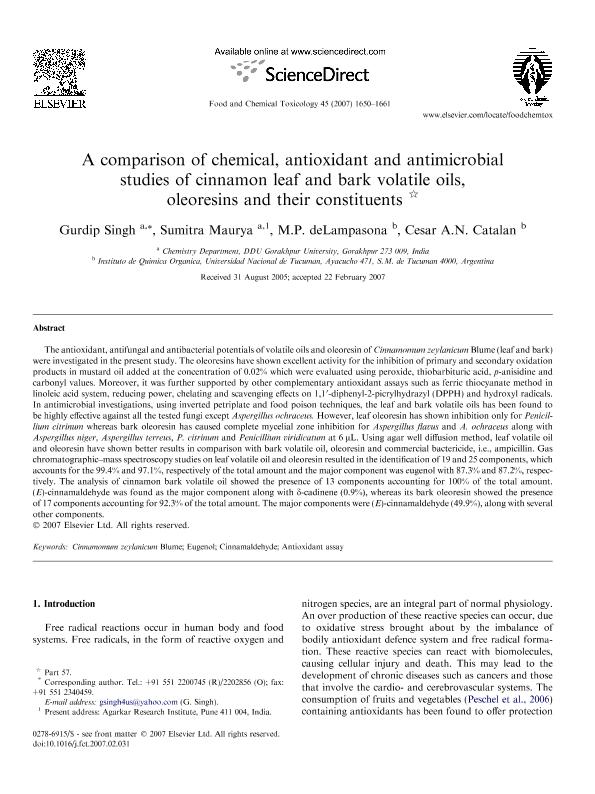Artículo
A comparison of chemical, antioxidant and antimicrobial studies of cinnamon leaf and bark volatile oils, oleoresins and their constituents
Fecha de publicación:
09/2007
Editorial:
Pergamon-Elsevier Science Ltd
Revista:
Food And Chemical Toxicology
ISSN:
0278-6915
Idioma:
Inglés
Tipo de recurso:
Artículo publicado
Clasificación temática:
Resumen
The antioxidant, antifungal and antibacterial potentials of volatile oils and oleoresin of Cinnamomum zeylanicum Blume (leaf and bark) were investigated in the present study. The oleoresins have shown excellent activity for the inhibition of primary and secondary oxidation products in mustard oil added at the concentration of 0.02% which were evaluated using peroxide, thiobarbituric acid, p-anisidine and carbonyl values. Moreover, it was further supported by other complementary antioxidant assays such as ferric thiocyanate method in linoleic acid system, reducing power, chelating and scavenging effects on 1,1′-diphenyl-2-picrylhydrazyl (DPPH) and hydroxyl radicals. In antimicrobial investigations, using inverted petriplate and food poison techniques, the leaf and bark volatile oils has been found to be highly effective against all the tested fungi except Aspergillus ochraceus. However, leaf oleoresin has shown inhibition only for Penicillium citrinum whereas bark oleoresin has caused complete mycelial zone inhibition for Aspergillus flavus and A. ochraceus along with Aspergillus niger, Aspergillus terreus, P. citrinum and Penicillium viridicatum at 6 μL. Using agar well diffusion method, leaf volatile oil and oleoresin have shown better results in comparison with bark volatile oil, oleoresin and commercial bactericide, i.e., ampicillin. Gas chromatographic-mass spectroscopy studies on leaf volatile oil and oleoresin resulted in the identification of 19 and 25 components, which accounts for the 99.4% and 97.1%, respectively of the total amount and the major component was eugenol with 87.3% and 87.2%, respectively. The analysis of cinnamon bark volatile oil showed the presence of 13 components accounting for 100% of the total amount. (E)-cinnamaldehyde was found as the major component along with δ-cadinene (0.9%), whereas its bark oleoresin showed the presence of 17 components accounting for 92.3% of the total amount. The major components were (E)-cinnamaldehyde (49.9%), along with several other components. © 2007 Elsevier Ltd. All rights reserved.
Palabras clave:
ANTIOXIDANT ASSAY
,
CINNAMALDEHYDE
,
CINNAMOMUM ZEYLANICUM BLUME
,
EUGENOL
Archivos asociados
Licencia
Identificadores
Colecciones
Articulos(INQUINOA)
Articulos de INST.DE QUIMICA DEL NOROESTE
Articulos de INST.DE QUIMICA DEL NOROESTE
Citación
Singh, Gurdip; Maurya, Sumitra; deLampasona, M.P.; Catalan, Cesar Atilio Nazareno; A comparison of chemical, antioxidant and antimicrobial studies of cinnamon leaf and bark volatile oils, oleoresins and their constituents; Pergamon-Elsevier Science Ltd; Food And Chemical Toxicology; 45; 9; 9-2007; 1650-1661
Compartir
Altmétricas




